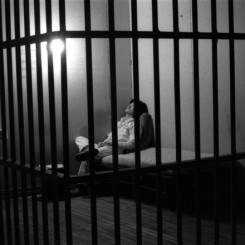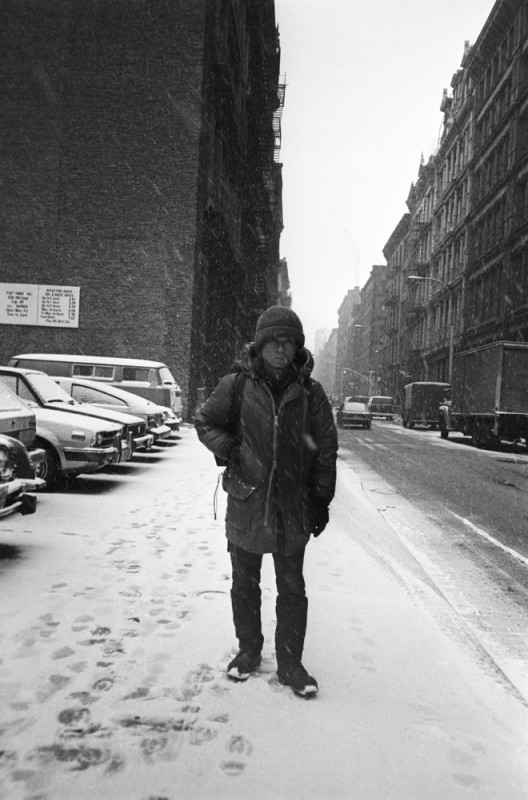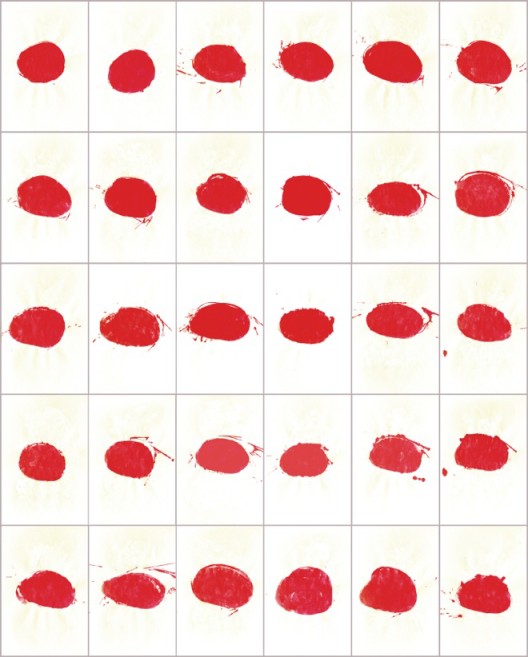Tehching Hsieh is a sprightly, eager person, lively in conversation. He is a seminal figure in the history of performance art, though his original actions were conducted largely in isolation and witnessed at first hand by precious few. Only in recent years has Hsieh—whom Marina Abramovic (a decidedly more visible artist) calls “A Master”—been recognized for his commitment as an artistic figure, conducting himself through a series of performances which serve as profound and decisive investigations into human diligence and experience.
Born in 1950 in Taiwan, Hsieh arrived in Philadelphia on a ship in 1974, having trained as a sailor as a means to get to America. Before leaving Taiwan, he had made paintings, a performance of duration wherein he turned over a legion of photographic sheets which gradually reacted to the sunlight, then turned them back over again, and jumped from a window, breaking both ankles. His life’s major series of performance art works commenced in 1978 with “One Year Performance 1978-1979”—the “cage piece” in which Hsieh spent a full year locked inside a wooden cage he built himself in his second floor studio at 111 Hudson Street. “Time Clock” [as it is informally named] followed from 1980-81 (“One Year Performance 1980-1981”), for which he set himself the task of clocking in and photographing himself every hour for one year. From 1981-2, armed with a sleeping bag, Hsieh stayed outside, forbidding himself from entering any kind of shelter (“One Year Performance 1981-1982”). July 1983-July 1984 was spent tied to the artist Linda Montano with an 8-foot rope, forbidden from touching (“Art/Life One Year Performance 1983-1984”). In 1985-6, Hsieh permitted himself no contact with or talking about art—“I just go in life,” read the artist’s statement (One Year Performance 1985-1986). For a final documented piece from 1986-1999 (from his 36th to 49th birthdays), Hsieh promised to make art, but not to show it publicly (“Tehching Hsieh 1986-1999”).
In 2009, 31 years after it was first undertaken in Hsieh’s adopted city, the cage and documentation from “Cage Piece” were exhibited at the Museum of Modern Art. The same year, “Time Clock Piece” was featured as part of “The Third Mind: American Artists Contemplate Asia, 1860–1989” at the Solomon R. Guggenheim Museum. Further presentations of selected works have followed—but no retrospective, the form for which Hsieh envisions carefully.
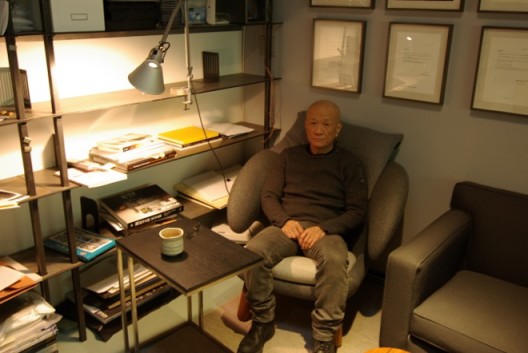
Tehching Hsieh at his studio, New York, 2015. Photo: Iona Whittaker
謝德慶在他的工作室,紐約,2015。 圖片提供:Iona Whittaker
Iona Whittaker: You don’t very often give interviews, do you?
Tehching Hsieh: No, I always feel I am repeating myself—you know, similar questions. But I forget, too. Every time it’s new! I just say what I know, simply.
IW: You seem like a practical person.
TH: I don’t write because I’m not a language person, I just do. [Laughs]. I feel my work needs some sort of bridge; every conversation means I learn a different point of view. I have my way to approach things. Some people want you to be more political, but actually I am more like a cave man—primitive. I trust my intuition. Of course, I understand civilization; New York is civilized—very strong. I came to do my work in the city; I didn’t go to the mountains to be a hermit because I knew that staying in the city to do this kind of work would be ironic, and that’s what I wanted. I am more interested in philosophical thinking. But I leave my work open to different interpretations. For example, some people think of the time clock piece as industrial, as if it is about workers.
IW: As labor?
TH: But that is talking only about working. I’m also talking about life. It’s not a 9-5 job: I lived in it, 24 hours a day for a year—it is life. Your heartbeat continues. Art and life become one. My work shows different perspectives of thinking about life. For me, life is a life sentence; life is passing time, life is free thinking.
IW: You put yourself in a situation, and stay absolutely in that situation.
TH: Right. Basically, I use time. Life is passing time; how to pass time is not my concern. It doesn’t matter what kind of life one has—everybody makes their own schedule. I created my schedule for passing time. I don’t do art anymore, but to me doing life and doing art is all the same—doing time. The difference is that in art, you have a form.
This approach gives me freedom—nobody tells me what to do or expects what my work should be. If they say I’m not good any more, that doesn’t bother me. I don’t feel I owe anybody anything [laughs].
IW: I think, for you, it’s not about whether you have succeeded; it’s more a case of “Do I feel I need to do more work like this?”
TH: Adrian (Heathfield, who co-authored with Tehching Hsieh Out of Now, a monograph on Tehching’s work) said I am like a successful failure! [Laughs]. It means I tried—I did four pieces and then the last two. I created, then I became less creative; the first four works are footnotes for the last two—it’s time passing. I think about how free I could be and how far I could reach. Each time you are presented with a choice; when I say I’m not making art any more, it’s my exit.
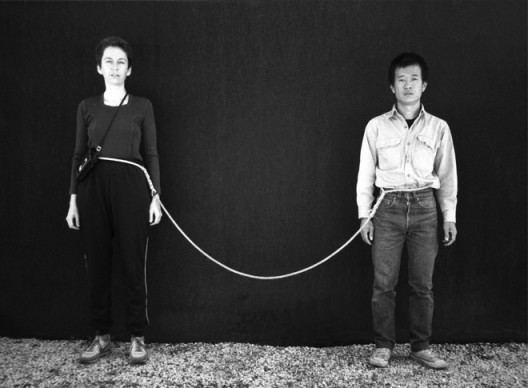
Tehching Hsieh, Linda Montano, “Art/Life One Year Performance 1983-1984,”
life image © Tehching Hsieh, Linda Montano
謝德慶,Linda Montano,《一年行為表演1983-1984》 © 謝德慶,Linda Montano
IW: Freedom, in many ways, is the ability to make a decision.
TH: I don’t see art as a career—it’s simply my life. At the beginning, I was at the bottom line [Tehching washed dishes and cleaned restaurants for four years upon arrival in the US]. I was passing time in a basic way. I didn’t know many things, but at least I practiced. I asked myself questions and I tried to find answers. You won’t be able to find answers from others or from knowledge— you have to go back to yourself, practice a lot, then answers will gradually emerge. I think this is essential. Through art, you transform.
IW: What did you ask yourself?
TH: I think everybody has some focus—something that makes you more stuck or more confused. And you want to fix it. You find answers by practicing, then you move on. This is something to do with art. What could I do in life in order to do art? I dropped out of high school, entered the United States illegally. I did six pieces, lived in art, passing time; then, in 2000, I stopped doing art. I’m doing life, still passing time; I don’t feel much difference. I plan to do a retrospective. I need a 900 x 70 foot space to show my lifeworks—22 years all together. The timing of the show is not important—it’s important that the concept is brought up. I’m glad I didn’t have a gallery when I did those early works; people would have collected my work, then it would have gone everywhere and I would feel that this long, intentional duration of my work and its sequence had just been thrown away. If I had been successful back then, it would have been a problem.
IW: I hope it happens. Early on, you made paintings, didn’t you?
TH: Yes. I understand art from painting. Some say I jumped from painting to performance, but I can only do one step at a time. I can’t jump. But maybe my steps are big.
IW: This is something I wanted to talk about. The way you approach things seems quite extreme. You do art or don’t do art; you stay inside, or outside; your work is visible, or invisible.
TH: My whole life has been about art and growing. I was very much into painting, including during three years of compulsory military service. The work was not mature, but at least I did it, and I grew. I feel I’m more an action kind of person. I did paintings of an active kind. That’s how I understand my work.
IW: So really, you changed the method from creating paintings to action itself—not making something, but being it.
TH: Right. Like breathing, lived in art-time…
IW: But when you came here, it was with a very clear purpose: you wanted to be a real artist.
TH: Yes. But I felt good doing my work in an illegal context; it was difficult, but I had some kind of freedom. I had no identity. Of course, that’s a difficult status, but it gave me energy. If you’re scared, you can’t do it. You have to take the risk. In 1974 when I came here [to the US] I was 24, and didn’t even know Soho. I went to Washington Square and saw people painting portraits in the street. I thought that was the art scene in New York. I found Soho by accident.
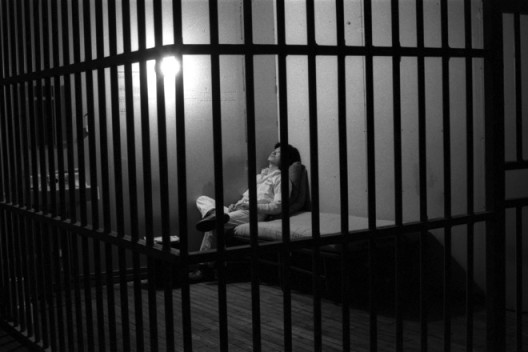
Tehching Hsieh, “One Year Performance 1978-1979,” life image, photograph by Cheng Wei Kuong © Tehching Hsieh
謝德慶,《一年行為表演1978-1979》, 攝影 程偉光, © 謝德慶
IW: Talking of confidence, it must have taken real bravery to do the cage piece. I wondered what made you feel confident at the time—or perhaps you didn’t?
TH: The experience was strong. I had already wasted four years [doing menial work], so I could waste one more year of time to do art! I just changed the way of passing time. [Laughs] Of course, in my mind I thought it was new, but it was not really new—life before was already harsh. Staying in the cage was extreme, but if you turn back you just return to harsh reality. I tried to make it better than what went before.
IW: It was better because you made the decision to do it.
TH: Right, it had that quality. If I didn’t make it and went back to washing dishes, it would have been worse.
IW: So the worst thing would have been not to have completed it?
TH: Yes, yes. [Laughs heartily]
IW: When you did the time clock, you missed 133 punches, didn’t you?
TH: Yes, 133, 134.
IW: Does this mean anything to you, or is it just how it is? There is always something you cannot control.
TH: For me, it’s still natural. 94–95%, I made it. [Energetically, he pulls out the record] You see here? December was the worst month. Then I thought, “I mustn’t get worse!” Up to that point it was natural, but after December I felt concerned about it. The way I understand it is, if I got 100% right, it would feel too strict and not an understanding of human beings. This 94–95% means that I’m not perfect, and that’s human. If I got just 60%, of course, the audience would think, “You didn’t do this job well.” But I would say that everybody is different; some people could do better than me, I’m sure. But nobody would want to waste time doing this without a reward. [Laughs heartily again.]
IW: Speaking of support, your family supported you, didn’t they?
TH: They did; they really have a good heart to support me, and they did what they could, but it doesn’t mean we really had an understanding. I know it’s better that I stay here. Here, I have more freedom; I am the oldest son, but I don’t behave like a Big Brother. I left Taiwan, so I cannot expect more from them— that’s the price I pay. I think the worst thing is if you admit your guilt but don’t do anything to change it. So, I would rather not confess.
IW: But you have a great sense of humor.
TH: Thank you. I’m not always that serious. I’m not masochistic. No matter how hard life is, you still have to laugh, otherwise you can’t continue.
IW: I think these performances would not work without a light heart. I imagine people ask you: “Is this a fulfilling thing to do?”
TH: Well, it’s not easy to complete the work, but the work is not about endurance. I pass time in an art form. I did work every hour, continuously, like breathing. It is one year, a cycle. It doesn’t matter if you’re creative not, or if you are poor or rich. The quantity of one year of time is the same; that is universal. I just keep the work basic, keep my life simple. But you need complexity in order to be simple.
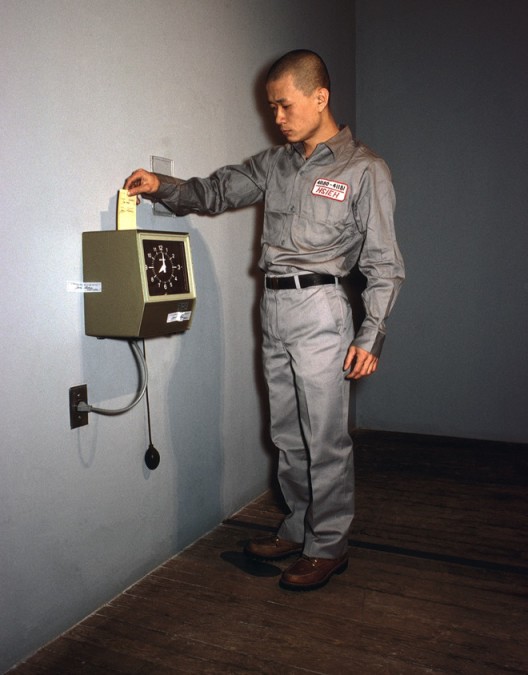
Tehching Hsieh, “One Year Performance 1980-1981,”life image, photograph by Michael Shen © Tehching Hsieh
謝德慶,《一年行為表演1980-1981》, 攝影 沈明琨, © 謝德慶

